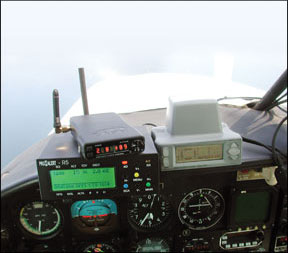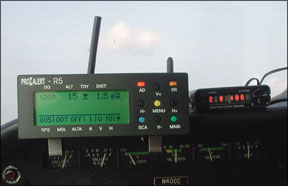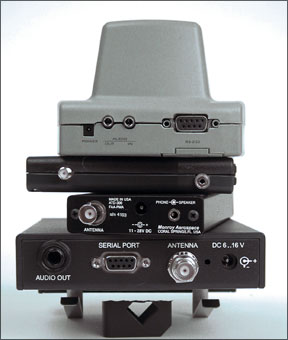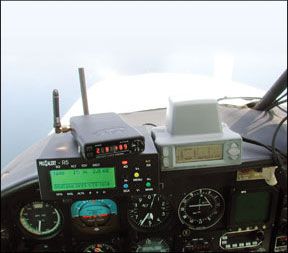Although the odds of it happening are higher than, say, getting whacked by an errant comet, midair collisions don’t rank as top accident causes. Lets hear it for big sky theory. Nonetheless, enough pilots worry about midairs to have sparked a lively market in both panel-mount and portable traffic alerters. Between the portable and panel mounts, there are at least seven systems available ranging in cost from under $500 to nearly $20,000. But are the portables really worth the investment? We think the answer is yes, if a midair collision rises to the top of your list of personal fears. Even the most expensive alerter-Zaons XRX-is still a relatively modest investment and although it wont see all of the traffic, it will see enough to earn its keep. For this report, we tested all of the current portable alerters, flying all of them against the three top panel-mount systems-L3s Skywatch, Garmins TIS and the Avidyne TAS600.
Zaon XRX
Zaon evolved from SureCheck Aviation, which introduced a line of portable traffic alerters about six years ago. Under the Zaon banner, the company has the premium priced XRX model ($1785 discounted) and the bargain MRX, at $489.
Zaon calls these devices PCAS, for portable collision avoidance systems. The XRX brought new capability to the field in its unique ability to detect not just range, but also azimuth, which it does through what Zaon calls a signal amplitude/phase cancellation antenna mounted in the truncated pyramid atop the receiver. The Zaon models also have their own onboard altimeters, so if the host aircraft transponder fails or doesnt function correctly, the device can still display relative altitudes to tracked aircraft. Its also capable of showing aircraft heading through a built-in electronic compass, which helps with relative bearing, too.
The XRX will detect and display up to three target aircraft, showing range, bearing-with pointer arrows-and relative altitude trends. Threat aircraft can also be displayed graphically via a range ring presentation. All of this data appears on a single, smallish LCD screen, which is the XRXs biggest weakness.
We found it all but impossible to read the screen in bright Florida summer sunshine with sunglasses on. If you want azimuth, the way to go, we think, is to use one of the XRXs remote display options, such as the Garmin GPSmap 396 or the Anywhere Map products from Control Vision. Performance wise, the XRX did well. When it picked up targets, the azimuth was always correct-it shows targets in 45-degree quadrants-and it handled multiple targets in the traffic pattern in a way that made sense. The XRX is sensitive to panel placement; it needs to be as level as possible and it doesnt like to be near obstructions such as the mag compass or a window post. Zaons manuals-which are first rate for the XRX and the MRX-explain this in detail, along with general operating principles.
Zaon MRX
This is Zaons bargain product, although its performance belies the word “bargain.” The MRX is tiny, measuring 4 by 2 by inches and weighing under 6 ounces with two AA batteries. It will also operate on ships power-12 to 40 volts. A small antenna screws into the left side of the device and there’s a jack for the audio alerts, which are tones only. The MRX is one of the better designed gadgets of any kind that weve ever tested. The bright red LED display is highly visible and logically designed and the single control knob-a round rocker-is easy to use.
Advertised range is up to 5 miles and like the XRX, it shows relative altitude of targets, with trends. It also has a built-in altimeter to fill in for an errant transponder and although it will track multiple targets, it has no azimuth capability. The version we obtained from Gulf Coast Avionics was shipped with a ships power cord and an audio cable with a splitter to tie in a headset.
The MRX will issue advisories for distant traffic and alerts for closer threats, depending on distance and relative altitude. It displays data for what it calculates to be the most immediate threat, but if another target comes into view, it flashes “new,” then gives the new target data.
The MRXs performance was excellent. Like the others, it missed traffic, but generally, it locked on quickly and gave practical if not perfectly accurate range numbers. The audio alerts are logical and easy to interpret. Without question, the MRX was best at tracking traffic approaching from the rear. On some of the passes, only the MRX saw an airplane in our 6 oclock.
ProxAlert R5

We first tested the ProxAlert R5 in June 2004, at which point it was priced at $1045. It has since been reduced to $775, discounted and it also earns our award as the least promoted aviation gadget we know of. The company simply doesnt advertise it much, if at all, and we had to look hard to even find it. Thats too bad, because we think its an excellent product.
The R5 is the largest of the four alerters, measuring 5 by 4 by 1 inches. One advantage of its size is that its LCD screen is also larger, 40 percent larger than the Zaon XRX. So while it suffers the usual LCD minimal contrast, the fact that its larger makes it easier to read.
Further, the R5 clips to the edge of the glareshield and can be placed directly in front of the pilots eyes. Unlike the XRX, its not especially sensitive to placement. The R5 runs on ships power only, but has an odd voltage range-6 to 16 volts; no 24-volt option. It also has audio alerts and is shipped with a Y-cable for patching into ships audio or a headset.
The R5 is a bit more complex to operate than the other products, with range setting adjustable in both the horizontal and vertical dimensions. There are seven buttons on the R5 to run through the setup menus and adjustments and although these arent logically labeled, in our view, they can be mastered with some quality time spent with the manual. But you cant skip that step.
Display wise, the R5 will show up to three threats, which it ranks according to

vertical and horizontal proximity. The threats appear in textual columnar format, with squawk code, relative altitude and distance. Small symbols are used to show whether the traffic is above, level or below the host airplane.
The R5 proved to be a solid tracker, acquiring targets quickly and holding on to them. We did notice that in close, it occasionally dropped our target airplane and it tended to be the outlier on estimated range. On several passes with the target known to be at 3 miles, the MRX and XRX showed it closer, while the R5 showed it more distant. But again, range performance among all the units was almost random in its inconsistency.
Monroy ATD-300
The ATD-300 was one of the first alerters to hit the market and has remained relatively unchanged since. Its nearly as small as the Zaon MRX-about an inch longer-and has a small, rear-mounted antenna and an audio jack for its voice alerts. Although the MRX can be panel mounted, Monroy actually provides detailed information on panel-mounting the ATD-300, including a documentation sample and advice on an external antenna.
The unit has a detection range of 5 miles and a switch to reduce annunciation of threats closer than a mile and 1000 feet. The alerts can also be muted. The ATD-300 has another feature we like: a continuous bus voltage monitor and it will voice and text-annunciate off-voltage conditions. (The unit will operate on 11 to 28 volts and the voltage alert is both settable and suppressible.)
The ATD-300 tracks only one target at a time, but when it detects a closer threat, it automatically switches its data display to that target. Unfortunately, there’s no easy way for the user to see how or when this is happening, as with the ProxAlert and Zaon products.
The ATD-300 didnt track as we’ll as the other devices, in our estimation. It missed more targets and even when it did acquire, it tended to drop them more often. Its ranging accuracy was par for the course-which is to say erratic. We tried moving the unit around on the glareshield, but were not sure it helped much.
Conclusion
As noted in the test summary on page 5, the performance of all these gadgets can be described in one word: inconsistent. They rarely agree on range to the target and we found that they didnt perform consistently from pass to pass. But that in no way suggests they arent worth having-just don’t expect TCAS performance from a $500 portable. And since Zaons MRX is at that price point, we’ll start there.When we tested the MRX last spring, we were impressed with its performance and these more exhaustive trials confirm that opinion. The MRX is the walkaway winner as the top value-it does the most for the least. When all the alerters went blank, the MRX could often still see the target and it tended to acquire targets before the other three. It excelled at seeing traffic in the 6 oclock position and the audio alerts are especially we’ll executed. If you want a simple alerter thats as reliable as these things are likely to be and capable of running on batteries, we can recommend the MRX without reservation.
We would rate the ProxAlert R5 next. Its a competent, well-executed product. It tracked targets well, perhaps a little better overall than the MRX, and we liked the way it presents multiple targets in column-and-row format. Although its somewhat complex to use, a little time with the manual clarifies any questions. However, it wont run on internal batteries and the lack of a 24-volt version will eliminate it from consideration for some owners. Further, the devices LCD display was difficult to read in bright sunlight. This also proved a significant drawback for Zaons XRX, in our view. We found that it does a terrific job of finding targets and when it does, the azimuth seems to be correct. However, the LCD proved so difficult to see in the bright Florida sun that we had trouble interpreting what the device was telling us.
The obvious fix-and the way to get the most out of this top-dollar alerter-is to connect the XRX to an external display, such as the Garmin GPSmap 396. we’ll reserve final judgment until weve done that. In the meantime, if you want target azimuth, the XRX does a reasonable job of providing it.
Last, the Monroy ATD-300, which can be thought of as an old standby product. Although we liked its slim profile on the glareshield and the bright LED display, this alerter was outclassed by the others in tracking effectiveness, in our view. It didnt do we’ll with targets below and behind the airplane and head-to-head with the Zaon MRX, it finishes second.


